Keyboard Instruments
Calliope
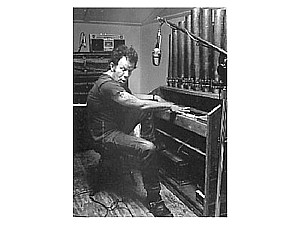
- Misery Is The River Of The World (Blood Money, 2002)
- Calliope (Blood Money, 2002)
- A Good man Is Hard To Find (Blood Money, 2002)
From the time the steam calliope was invented by J.C. Stoddard in the 1850s, it found a special niche in circuses and riverboats. Requiring a boiler to generate steam to blow through the pipes, calliopes ranged from 32 to 53 notes in scope, and some models could be heard for several miles. This was good for showboats or circuses announcing their arrival in town, but bad for the individual playing the device, and the premature onset of deafness was commonplace among calliope performers. By the early 1900s, many calliopes were automated through the use of a cylinder or roll, which didn't replace artists altogether, but helped to minimize their exposure to the noise.
JB (2002): "On the albums (Alice/ Blood Money), the self-described "sound hound" used some odd instruments, including a Stroh violin (a violin with a horn appendage), a calliope (found by his brother-in-law on a flatbed truck in Iowa) and percussive Indonesian seed pods (with seeds the size of grapefruits)." (Source: "Tom Waits peers through the looking glass on two new discs" Star Tribune (USA) by Jon Bream. February/ March. Published: May 5, 2002)
JP (2002): "The music drags hymns and parlor songs, blues and ballads into a sonic menagerie that, on the new albums, includes Swiss hand bells, calliope and a four-foot-long Indonesian seed pod, which is "as wide as a Bible," he said, and has "seeds as big as CD's." (Source: "Tom Waits: A Poet of Outcasts Who's Come Inside" New York Times (USA) by Jon Pareles. Published: May 5, 2002)
JS (2002): "On ''Blood Money,'' which debuted in 2000, Waits lost the string section but added a 1929 pneumatic calliope - an old circus instrument with 57 whistles - harmonica, and a dried boomerang seed pod from a rare tree that grows only in Indonesia." (Source: "With morbidity on his mind, Tom Waits makes a double play" The Boston Globe (USA) by Jim Sullivan. Published: May 5, 2002)
GK (2002): To give "Alice" and "Blood Money" their distinctive characters, Waits introduced a few more oddities to his sound-making arsenal: a stroh violin (a violin crossed with a brass horn), a pod (a four-foot seed pod from Indonesia, used as a percussion instrument) and a 1929-vintage pneumatic calliope." (Source: "2 albums at once? That's Waits' way Chicago Tribune (USA) by Greg Kot. Published: May 5, 2002)
Q (2002): Where does one buy a pneumatic calliope, with 57 whistles? TW: "In Iowa, actually.Back of a flatbed truck. It was a small, red-suspender band, their sleeves held up with elastic, wearing straw hats. Greg Cohen, who's married to my wife's sister and has been my bass player for many years, asks if it's for sale. `Absolutely.' So he gives me the phone number. Says his wife would kill him if he purchased a calliope. So he decided to let my wife kill me, instead. I paid 2 grand for it, and it needed work. It's just like buying a used car . . . a background in car repair would be more advantageous than a background in music in working with it, because it's all hoses and pipes. It took four guys to carry it . . . when we played it in the studio, people for miles around complained of the noise." (Source: "2 albums at once? That's Waits' way Chicago Tribune (USA) by Greg Kot. Published: May 5, 2002)
DC (2002): "Like all Waits' efforts since Swordfishtrombones ('83), it's stylistically varied, with an overall production "patina"--in this case a dry, raspy shibui (the Japanese word for dilapidation) sound personified by the pod (a 4-foot-long Indonesian bean shaker), marimbas and a 57-whistle pneumatic calliope that reverberated for five miles in the Sonoma shack where the CDs were recorded." (Source: "Blood on the looking glass" Chico News and Review (USA) by Dan Cohen. Published: May 7, 2002)
Q (2002): So, did that calliope have a volume control? TW: "No it does not. It's pneumatic, it's ear-bleeding loud. Greg found it. ... He gave me the number and told me to buy it. It took six guys to pick it up put it in the back of an El Camino. Don't ask why, but for some reason all these calliope people live in Iowa--there's a whole coven of calliope people. They congregate like circus people who have settled in Tampa, Flo. ... But [the calliope] is very loud, it's designed to be heard from five miles away. So if you can imagine that, but you're sitting next to it." (Source: "Blood on the looking glass" Chico News and Review (USA) by Dan Cohen. Published: May 7, 2002)
CW (2002): On Blood Money, he solos on a 57-whistle, 1929 circus calliope. Where did he get it? "All these calliope guys live in Iowa, for some reason," he says, "and they're a grumpy group. If you don't know your calliopes, they want nothing to do with you. I made the mistake of describing the whistles as 'pipes' -- and the guy hung up on me! (Source: "A double shot of Waits Globe and Mail (Canada) by Carl Wilson. Published: May 7, 2002)
PD (2002): To add to the songs' (Alice/ Blood Money) other-wordliness, Waits uses the Mellotron (an early synthesiser), which had its heyday in the 1970s in bands such as the Moody Blues, and his latest "found objects", such as a 1929 pneumatic calliope (an old circus instrument with 57 whistles) and a dried boomerang seed pod from a rare Indonesian tree." (Source: "Lying in Waits" The Age (Australia) by Patrick Donovan. Published: May 10, 2002)
TW (2002): "Playing a calliope is an _experience_. There's an old expression, 'Never let your daughter marry a calliope player.' Because they're all out of their _minds_. Because the calliope is so flaming _loud_. Louder than a bagpipe. In the old days, they used them to announce the arrival of the circus because you could literally hear it three miles away. Imagine something you could hear three miles away, and now you're right in front of it, in a studio...playing it like a piano, and your face is red, you're hair is sticking up, you're sweating. You could scream and nobody could hear you. It's probably the most visceral music experience I've ever had. And when you're done, you feel like you should probably should go to the doctor. Just check me over, Doc, I did a couple of numbers on the calliope and I want you to take me through the paces." (Source: "Play It Like Your Hair's On Fire" GQ magazine (USA) by Elizabeth Gilbert. June 2002. Published: May 2002)
Q (2002): You have a legendary love for exotic instruments, yet I'm still surprised you managed to incorporate something as unwieldy as a 1929 pneumatic calliope, which sounds merry and haunted at the same time. TW: "It's ear-bleeding loud. It has all these pipes that look like radiator hoses. If you call the whistles "pipes," by the way, a calliope player will hang up on you. I loved it. You can scream when you're playing it and not be heard. I'd like to see more of it in popular music." (Source: "I hope more people misunderstand me" USA Today (USA), by Edna Gundersen. Published: June 17, 2002)
Celeste (Celesta)
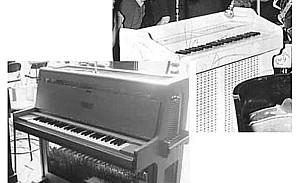
- Ice Cream Man (Closing Time, 1973)
- Presents (One from The Heart, 1982)
The Celeste is a small set of tuned orchestral bells with a keyboard mechanism, and its sound is "heavenly", like its name indicates. It looks like a small piano but it has a tuning-fork inside instead of strings. There are several manufacturers of celeste, namely Yamaha, Mustel and Schiedmayer. Although the celeste was invented by Mustel in the 19th Century, Schiedmayer are now the most recognisable celeste manufacturer. The celeste is similar to a keyed glockenspiel in that it has metal bars with a keyboard action. However, whilst the action is the same the sound is much less metallic due to the felt covered hammers and the fact that each note has its own resonator box and damper mechanism. Whilst the celeste looks much like a piano, they are considerably shorter and have only a single sustain pedal.
Chamberlin*
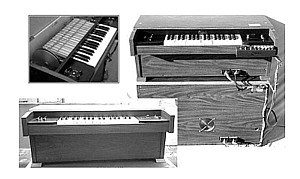
- Earth Died Screaming (Bone Machine, 1992)
- The Ocean Doesn't Want Me (Bone Machine, 1992)
- In The Colosseum (Bone Machine, 1992)
- Crossroads (The Black Rider, 1993)
- The Last Rose Of Summer (The Black Rider, 1993)
- Carnival (The Black Rider, 1993)
- Black Market Baby (Mule Variations, 1999)
- Everything You Can Think (Alice, 2002)
- Reeperbahn (Alice, 2002)
- Barcarolle (Alice, 2002)
- Everything Goes To Hell (Blood Money, 2002)
- Coney Island Baby (Blood Money, 2002)
- Starving In The Belly Of A Whale (Blood Money, 2002)
The Chamberlin was the original US keyboard instrument from which the Mellotron was copied, designed by Harry Chamberlin in the USA during the 1960's. The Chamberlin used exactly the same system as the Mellotron for playing back tape samples yet had a sharper more accurate sound. Compared to the Mellotron, the Chamberlin is a bit harder to play, requiring a rather heavy and consistent hand on the keys.
Derk Richardson (1992): One of the dinosaurs Waits reclaimed on Bone Machine is the Chamberlain, a pre-synthesizer keyboard that taps into analog tape loops of pre-recorded material. TW: "It's stunning, really, I have like 70 voices on the instrument, from horses to rain, laughter, thunder, seven or eight different trains, and then all the standard orchestral instruments. It's a good alternative if you don't like the sound of the more conventional state-of-the-art instruments - sometimes it's like they've had the air sucked out of them." (Source: "Composer, musician, performer, actor Tom Waits..." Pulse!: Derk Richardson. September, 1992)
Jim Jarmusch (1992): Explain the Chamberlain. The first keyboard sampling instrument. The Chamberlain 2000. TW: It's a 70-voice tape loop, it's a tape recorder, an elaborate tape recorder with a keyboard. JJ: What year was it made? TW: I think maybe '60, '61 or '62. Musicians were afraid it was gonna put 'em out of business, because it was too real. It was like, oh my god... And if somebody had one of these, why ever hire a band? It's too perfect... JJ: Yeah, but that's what they say about synthesizers now. And people would still rather hear the real instruments. TW: A lot of scores are done on a synthesizer. JJ: I like the Chamberlain because it sounds like it breathes somehow. Maybe it's the action of the keys that you once showed me that cause a delay, so that it changed the way you played. TW: It changes the physicality of your approach to the instrument, because the keyboard is not easy (to play). It goes down too far, your fingers get stuck down there and can't get back up. JJ: They were made in L.A.? TW: Yeah. By Richard Chamberlain. Not the actor (laughs). There's a bicycle chain in it, and if the tape gets on the other side of the chain it can damage the tape. Tchad Blake actually spent four or five hours working on it, repairing it. (That's why I say) there are no gamblers in 'Chamberlain Pass'. You get decorated for valor. It's like operating on a flamingo. You don't even know where the heart is, nothing. If you touch there, you know, the world will end. If you touch this tape here, I dunno, you may lose your hand. It has that kind of danger about it. JJ: How do you program tapes on it? TW: They just move to a different place on the tape. They give you about a 12-second sample that's the length of time it takes for the tape to move through the head, and give you about three feet of quarter-inch tape. JJ: You've got two of them, right? TW: I've got one Mellotron and one Chamberlain, and the Chamberlain I have is a prototype. So it's made with found electronic objects. JJ: How many were made? TW: Well, ultimately it was mass produced, and they were out there like Fender Rhodes, only on a much smaller scale. But they were marketed, advertised and sold in music stores, and they had displays, and everyone heard this name Chamberlain. JJ: Did you use it on 'Bone Machine'? TW: Only on two songs, on "The Earth Died Screaming" and "The Ocean Doesn't Want Me". JJ: What other stuff did you use it on previously? TW: I used it a lot on "Frank's Wild Years". (Source: "Tom Waits Meets Jim Jarmusch" Straight No Chaser magazine (UK) Vol. 1, Issue 20 Jim Jarmusch. October, 1992 (published early 1993))
Jim Jarmusch (1992): "You have a Mellotron, and of course, the Chamberlain 2000. TW: Ah, the Chamberlain. It has a full sound effects bank that's thrilling. It has the sound of Superman leaving the window. It has storms. It has wind, rain and thunder. There are three keys right next to each other. What I have is a prototype, so its got whatever he discovered. In fact on some of 'em even, at the end of the sample you hear, "Okay, that's enough." You hear the engineer. JJ: Seriously? Where did you find it? TW: I bought it from three surfers who lived in Westwood who had a full state of the art room filled with every current -- they had decambodeizers -- JJ: Deneutralizers. TW: They had the Tascam 299 with a 300 count back -- JJ: With a hertz shifter. TW: Yeah. JJ: Hooker Headers on it. TW: They were laughing at the Chamberlain. I would have none of it. JJ: Ridiculing it? TW: Ridiculing it. I said, "I will take this from you." I got it for three grand. JJ: They know who you were? TW: No. I was just a guy. They were playing it and laughing at all the sounds it made, and I let them laugh knowing it would soon be mine and I would treat it better. JJ: They probably laughed that you paid that much for it. TW: Yeah. JJ: Little did they know. But then, they'll never know. TW: They'll never know. It's got a variety of trains, it's a sound that I've become obsessed with, getting an orchestra to sound like a train, actual train sounds. I have a guy in Los Angeles who collected not only the sound of the Stinson band organ, which is a carnival organ that's in all the carousels, the sound from that we used on 'Night on Earth', but he also has pitched four octaves of train whistles so that I can play the train whistle organ, which sounds like a calliope. It's a great sound."(Source: "Tom Waits Meets Jim Jarmusch" Straight No Chaser magazine (UK) Vol. 1, Issue 20 Jim Jarmusch. October, 1992 (published early 1993))
Robert Palmer (1993): "Ever since his film score for Mr. Coppola's "One From the Heart" (1982) and his own ground-breaking album "Swordfishtrombones" (1983), he has been resolutely broadening his musical palette, gravitating toward odd instruments (including a wheezing old proto-synthesizer called the chamberlain and a percussive sound sculpture known as the conundrum) and sonic textures." (Source: "Tom Waits, All-Purpose Troubadour" Robert Palmer, The New York Times: November 14, 1993)
Mark Richard (1994): "Yet here we are, in the control room where Mike Kloster, the second engineer, is patching in Waits' Chamberlain Music Master 600, a broken-lidded, organ-like contraption with over 70 sounds and voices on tape loops. Waits bought it from some surfers in Westwood who were making fun of the instrument. "I saw it and said, 'I'll take you home now, dear'," Waits recalls. Waits is hoping to coax a woman's voice from the machine, but its wooden pins and spinning chain-driven gears and tape loops are visibly dusty and brittle." (Source: "The music of chance" Spin Magazine: Mark Richard. June, 1994)
Tom Waits (1996): "In 1985, I answered an ad in The Recycler, and bought a Chamberlin Music Master 600from two teenage surfers in Westwood, California. The Chamberlin, created by Richard Chamberlin (not Dr. Kildare), is an early 60s analog synthesizer that stores all of its voices (over 60 in total) on tape loops, and with a series of pulleys and chains and springs plays an eleven second "memory" of prerecorded sound stored on the tape. Then a spring snaps it back to the beginning, and it's ready to play again. It's a keyboard instrument, and I believe I own one of the early prototypes, because the "preset" instrument menu is written in longhand. It contains some of the most haunting sounds I have ever encountered, including an operatic human voice (both male and female), Portamento trombone, pizzicato violin, chimes, gong, squeaking door, thunder and rain, train whistles and chugs, acoustic bass, cello, clarinet, applause and various birds and dogs. The Rube Goldberg mechanism inside is as fascinating as the curiously strange sounds it holds in its tape bank." (Source: "Sound Hound": Foreword by Tom Waits to Bart Hopkin's book/ CD: "Gravikords Whirlies & Pyrophones - Experimental Musical Instruments." Publisher: Ellipsis Arts. October, 1996)
NN: "I was just checking out your excellent Mellotron-related website when I came across the page about the Chamberlin Music Master. What a cool instrument. Tom Waits has a Music Master. Apparently he saw an ad in his local Recycler-type of paper and went to find out what this thing was. The previous owners were a couple of "surfer" types that would just turn the thing on a revel in the sound effects (there's a fireworks or FX tape on this one). Tom reportedly paid something like $400 for it. Tom uses it quite a bit! Most recently he put down some tracks using the Music Master's "vibraphone" sound, and you will probably hear it on Tom's releases in the Spring of 2002. Tom also has an M400 he likes very much, by the way." (Source: email as published on: Ken Leonard's Mellotron page. Subject: Music Master/Tom Waits Date: Wed, 2 Jan 2002 14:37:55 -0600)
* Often misspelled in liner notes as "Chamberlain"
Farfisa Organ
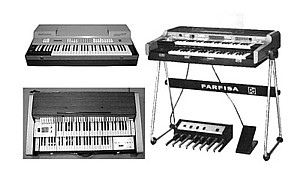
- Telephone Call From Istanbul (Franks Wild Years, 1987)
MR (1987): "Waits (also) plays a variety of keyboards, including a Brunello de Montelchino pump organ, a Farfisa organ and the famous Optigon, a keyboard made between 1968 and 1972 and marketed by Penney's stores." (Source: "Tom Waits is flying upside down (on purpose)" Sidebar. Musician: Mark Rowland. October, 1987)
BF (1987): "Waits had his own arsenal of prehistoric keyboards, the type you don't find on records these days. There's his wheezing pump organ, his plodding Mellotron, his tacky Farfisa and, of course, the Optigon."(Source: "Better Waits Than Ever" Music & Sound Output: Bill Forman. Vol. 7, No. 11. October, 1987)
BF (1987): "Waits' unconventional approach to recording doesn't end with his choice of instruments. "Telephone Call from Istanbul" goes rollicking along with banjo, guitar, bass, drums and the faint ghost of Waits improvising away on that cheesy Farfisa. When the track is nearly over, the Farfisa kicks in full strength, catapulting the listener into some hellish Turkish rollerskating rink. "I usually don't like to isolate the instruments," says Waits, explaining the appearance of the ghost early in the track. "On that song, I pulled out the Farfisa and then just put it in very hot at the end, just so it sounded kind of Cuban or something."(Source: "Better Waits Than Ever" Music & Sound Output: Bill Forman. Vol. 7, No. 11. October, 1987)
Harmonium
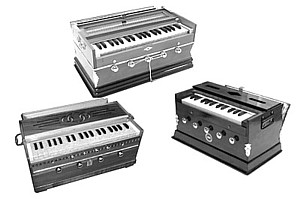
- Good Old Word - Waltz (Night On Earth, 1992)
- Laurent Wannenmacher (Alice theatre play, 1992)
TW (1983): "Some of the stuff I think is a bit of a departure for me. Ehm... the instrumentation is all different, and no saxophones. I used the banjo, accordion, bass-marimba, ehm metal aunglongs ehm you know African squeeze drum, a calliope, a harmonium. Eh, so some of the stuff is a little more exotic." (Source: "Saturday Live Interview With Tom Waits Source: BBC Radio One (UK) by Richard Skinner. October 22, 1983)
MT (1985): There hasn't been a lot of piano in either of the two Island records really. TW: No... MT: Does that mean you have been writing more with the guitar? TW: I guess it was some guitar and eh... I rented a little pump organ. It's a little harmonium, and I've been playing the accordion a little bit. I don't know, I've been trying to... It's interesting to write on instruments you don't understand." (Source: "CBC Nightlines Interview" Nightlines on CBC Stereo (Canada). Michael Tearson. New York, late 1985)
JJ (1992): "You have a harmonium, right? That was in the studio. TW: I have several." (Source: "Tom Waits Meets Jim Jarmusch" Straight No Chaser magazine (UK) Vol. 1, Issue 20 Jim Jarmusch. October, 1992 (published early 1993))
Leslie Bass Pedals
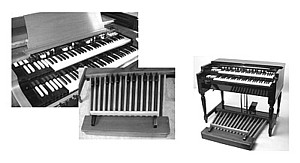
- Hang On St. Christopher (Franks Wild Years, 1987)
- Straight To The Top - Rhumba (Franks Wild Years, 1987)
A Hammond organ is an electromagnetic instrument, with an inside consisting of tons of wires, cables and tubes. The sound from the organ is produced by small cogwheels which are rotating in front of magnetic coils. The tone produced are amplified and transformed into different soundings by so called drawbars, theoretically giving the organist 252 million different sound and tone combinations to choose from. Another important ingredient in the making of the Hammond sound, is the famous separated Leslie speaker cabinet. Inside the Leslie you'll find a speaker mounted on a rotating disc, and when the disc is in motion, a periodical sound change occurs and the pitch is sounding to be alternately higher and lower. The Leslie Rotating Speaker was named after its inventor, DonLeslie. First models began to appear around 1940. It is designed as a sound modification device, not a hi-fi speaker. The pairing of the Leslie Speaker with another device, for instance the famous Hammond B3 organ, constitutes a musical instrument. Here Waits only plays the bass pedals of a Hammond B3/ Leslie combination.
TW (1987): "Little Jamaican shoeshine music, there (Hang On St. Christopher). Kind of a depraved Vaudeville train announcer. Ummm. . . It was really great to see Bill Schimmel, classically trained at Juilliard, on his hands and knees, playing the pedals of the B-3 organ with his fists. Working up a sweat. It was worth it just for that. Has kind of a little bit of a North African horn action going on --- that's Ralph Carney and Greg Cohen." (Source: "From the set of Ironweed, Tom Waits talks with Rip Rense" New York Post: Rip Rense. Early 1987)
MR (1987): "Cohorts include guitarist Marc Ribot, percussionist Michael Blair, bassist and horn arranger Greg Cohen, Ralph Camey on saxophone and William Schimmel on a variety of equipment, from accordion to Leslie bass pedals. Waits' instruments include pump organ, guitar, mellotron, even something called the optigon." (Source: "Tom Waits is flying upside down (on purpose)" Musician: Mark Rowland. October, 1987)
TW (1987): "I want to take the Leslie bass pedals and raise them up to a kitchen table so you can play them with your fists (on stage). Which is what we did in the studio on "Hang On St. Christopher. " I'm trying to put together the right way of seeing the music. I worry about these things. If I didn't, it would be easier." (Source: "Tom Waits is flying upside down (on purpose)" Musician: Mark Rowland. October, 1987)
Q (1987): Still, a bassline played using the footpedals of a Hammond organ? TW: "I used upright bass for so long, it's hard for me to find an electric bass that I like," he explains. "So that was the closest I could get. It's like a drum with a note in it, you know, real fat and out of focus. Bill Schimmel, the accordion player, played them with his hands. I'm thinking of taking them on the road and raising them to the level of a marimba." (Source: "Better Waits Than Ever" Music & Sound Output: Bill Forman. Vol. 7, No. 11. October, 1987)
TW (1987): "Things that happened in those sessions were really good. Especially when people were playing instruments they weren't familiar with. I had Ralph Carney, the sax player, on several cuts where he played three saxes at once. And then Bill Schimmel playing the pedals, Greg Cohen playing alto horn... Sometimes approaching an instrument you're unfamiliar with, the discovery process is good."(Source: "Better Waits Than Ever" Music & Sound Output: Bill Forman. Vol. 7, No. 11. October, 1987)
Further reading: Hammond organ 1, Hammond organ 2
Mellotron*
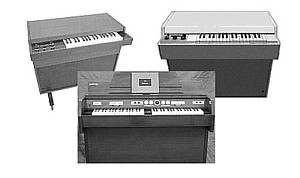
- Please Wake Me Up (Franks Wild Years, 1987)
- Everything You Can Think (Alice, 2002)
Mellotrons (and Novatrons) were produced in England by Streetly Electronics from the early '60s until the early '80 by Leslie Bradley and his brothers Frank and Norman. The original Mellotron was designed as an expensive domestic novelty instrument. The Mellotron was a precursor of the modern digital sampler. Under each key was a strip of magnetic tape with a recorded sound that corresponded to the pitch of the key (The Mark II had two keyboards of 35 notes each making a total of 1260 seperate recordings). The instrument plays the sound when the key is pressed and returns the tape head to the begining of the tape when the key is released. This design enables the recorded sound to keep the individual characteristics of a sustained note (rather than a repeated loop) but had a limited duration per note, usually eight seconds. Most Mellotrons had 3 track 3/8" tapes, the different tracks being selectable by moving the tape heads across the tape strips from the front panel. This feature allowed the sound to be easily changed while playing and made it possible to set the heads in between tracks to blend the sounds. Despite attempting to faithfully recreate the sound of an instrument the Mellotron had a distinct sound of its own that became fashionable amongst rock musicians during the 1960's and 1970's. The Novatron was a later model of the Mellotron re-named after the original company liquidised in 1977.
TW (1987): "Kathleen started out with the melody on that (Please Wake Me Up). It's just a little lullaby of some kind. With mellotron, baritone horn, upright bass." (Source: "From the set of Ironweed, Tom Waits talks with Rip Rense" New York Post: Rip Rense. Early 1987)
TW (1987): "The mellotron, I've been hearing about over the years, and I've always been afraid of it. You know, when you hit a key, you actually get that particular note taped on a particular instrument. So when you hit the note, it feels like you're tapping somebody on the shoulder and they begin to play. It's very real. Dream real. Most of the instruments on the tracks, though, can be found in any pawn shop. I haven't completely joined the 20th century." (Source: "From the set of Ironweed, Tom Waits talks with Rip Rense" New York Post: Rip Rense. Early 1987)
MR (1987): "Cohorts include guitarist Marc Ribot, percussionist Michael Blair, bassist and horn arranger Greg Cohen, Ralph Camey on saxophone and William Schimmel on a variety of equipment, from accordion to Leslie bass pedals. Waits' instruments include pump organ, guitar, mellotron, even something called the optigon." (Source: "Tom Waits is flying upside down (on purpose)" Musician: Mark Rowland. October, 1987)
BF (1987): "Waits had his own arsenal of prehistoric keyboards, the type you don't find on records these days. There's his wheezing pump organ, his plodding Mellotron, his tacky Farfisa and, of course, the Optigon."(Source: "Better Waits Than Ever" Music & Sound Output: Bill Forman. Vol. 7, No. 11. October, 1987)
TW (1987): "I've always liked the Mellotron as well. The Beatles used it a lot, Beefheart used it a lot. They're real old and they're not making them anymore. A lot of them pick up radio stations, CB calls, television signals and airline transmitting conversations. And they're very hard to work with in the studio because they're unsophisticated electronically. So it's almost like a wireless or a crystal set."(Source: "Better Waits Than Ever" Music & Sound Output: Bill Forman. Vol. 7, No. 11. October, 1987)
TW (1989): "I love that thing the Mellotron so much. I just used one yesterday. (Its owner) guards it with his life because it's such an exotic bird, it's a complete dinosaur, and every time you play it it diminishes. It gets old and eventually will die, which makes it actually more human, you're working with a musician that is very old, he's only got a couple more sessions left. It increases the excitement of it. And that great trombone sound... Those Mellotrons, the first time I actually played one, it really thrilled me. It's like you touched somebody on the shoulder, everytime I touch you on the shoulder I want you to play a note. It was that real." (Source: "Eavesdropping on Elvis Costello and Tom Waits" Option Magazine. July/ August, 1989)
PD (2002): To add to the songs' (Alice/ Blood Money) other-wordliness, Waits uses the Mellotron (an early synthesiser), which had its heyday in the 1970s in bands such as the Moody Blues, and his latest "found objects", such as a 1929 pneumatic calliope (an old circus instrument with 57 whistles) and a dried boomerang seed pod from a rare Indonesian tree." (Source: "Lying in Waits" The Age (Australia) by Patrick Donovan. Published: May 10, 2002)
* Misspelled in liner notes as "Melotron" or "Mellowtron"
Further reading: Mellotron 1, Mellotron 2
Optigan*
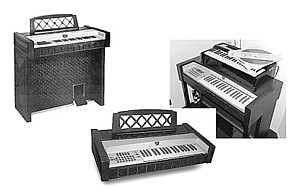
- Straight To The Top - Rhumba (Franks Wild Years, 1987)
- Temptation (Franks Wild Years, 1987)
- Please Wake Me Up (Franks Wild Years, 1987)
- More Than Rain (Franks Wild Years, 1987)
- Low Side Of The Road (Mule Variations, 1999)
The Optigan was a kind of home organ made by the Optigan Corporation (a subsidiary of Mattel) in the early 70's. It was set up like most home organs of the period - a small keyboard with buttons on the left for various chords, accompaniments and rhythms. At the time, all organs produced their sounds electrically or electronically with tubes or transistors. The Optigan was different in that its sounds were read off of LP sized celluloid discs which contained the graphic waveforms of real instruments. These recordings were encoded in concentric looping rings using the same technology as film soundtracks. As the film runs, a light is projected through the soundtrack and is picked up on the other side by a photoreceptor. The word "Optigan" stands for "Optical Organ". Some Optigan Disc Titles Banjo Sing-Along, Big Band Beat, Bluegrass Banjo, Bossa Nova Style, Cha Cha Cha!, Dixieland Strut, Folk & Other Moods-Guitar, Gay 90's Waltz (6/8 time), Gospel Rock, Guitar Boogie, Guitar in 3/4 Time, Hear and Now, Latin Fever, Nashville Country, Polynesian Village, Pop Piano Plus Guitar, Rock and Rhythm, The Blues-Sweet and Low, Waltz Time (3/4 Time).
TW (1987): "Kind of a floor show --- yeah, that was a little Louis Prima influence there (Straight To The Top---Rhumba). Louis Prima in Cuba. A little pagan. Not so Vegas --- more pagan. Like a guy who is obviously not going straight to the top, but the fact that he feels as though he is makes you almost believe that he might be; that somebody like that is going to burn a hole in something - but certainly not the business. Probably himself. We used the Optigon on that." (Source: "From the set of Ironweed, Tom Waits talks with Rip Rense" New York Post: Rip Rense. Early 1987)
TW (1987): "It's (The Optigon) one of the early organs created for home use. Where you have a program disc that you put inside the organ, and it creates a variety of sound worlds for you to become part of. Like they have the Tahitian/Polynesian number complete with birds and waterfall. And you can be a 32-piece orchestra --- instant adagio for strings, you know. There's a cabaret setting, a little jazz thing with a kind of Charlie Byrd feel to it." Q: "How did you use it on "Straight To The Top---Rhumba?" TW: "I believe it was set on the outdoor tropical thing. Rainforest. Don't try this at home yourself . . . They have these little floppy discs, a little door, and you put one in, close the door and . . . the magic happens." (Source: "From the set of Ironweed, Tom Waits talks with Rip Rense" New York Post: Rip Rense. Early 1987)
MR (1987): "Cohorts include guitarist Marc Ribot, percussionist Michael Blair, bassist and horn arranger Greg Cohen, Ralph Camey on saxophone and William Schimmel on a variety of equipment, from accordion to Leslie bass pedals. Waits' instruments include pump organ, guitar, mellotron, even something called the optigon." (Source: "Tom Waits is flying upside down (on purpose)" Musician: Mark Rowland. October, 1987)
MR (1987): "Waits also plays a variety of keyboards, including a Brunello de Montelchino pump organ, a Farfisa organ and the famous Optigon, a keyboard made between 1968 and 1972 and marketed by Penney's stores. The Optigon plays pre-recorded sounds, which can be selected from its library; Tom particularly likes "Polynesian village" and "romantic strings." (Source: "Tom Waits is flying upside down (on purpose)" Sidebar. Musician: Mark Rowland. October, 1987)
BF (1987): "Waits had his own arsenal of prehistoric keyboards, the type you don't find on records these days. There's his wheezing pump organ, his plodding Mellotron, his tacky Farfisa and, of course, the Optigon." (Source: "Better Waits Than Ever" Music & Sound Output: Bill Forman. Vol. 7, No. 11. October, 1987)
TW (1999): "That's (The Optigon) a mid-'60s keyboard that used floppy disks with optical filaments. It's like everything else in popular music: It finally washes up in the Salvation Army 20 years later, and someone picks it up, brings it home and makes a hit record out of it. Bury me, then dig me up-that's like the code of popular music." (Source: "Tom Waits for no man" Time Out New York nr. 187: Brett Martin. April 22-29, 1999)
* Often misspelled in liner notes as "Optigon"
Further reading: Optigan
Pump Organ (Reed Organ)
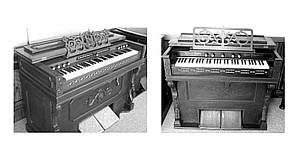
- Blow Wind Blow (Franks Wild Years, 1987)
- Innocent When You Dream - Barroom/ '78 (Franks Wild Years, 1987)
- Frank's Theme (Franks Wild Years, 1987)
- I'll Take New York (Franks Wild Years, 1987)
- Train Song (Franks Wild Years, 1987)
- Straight To The Top - Rhumba (Franks Wild Years, 1987)
- Good Old World - Waltz (Night On Earth, 1992)
- Pony (Mule Variations, 1999)
- Bebe Risenfors (Woyzeck theatre play, 2000)
- Flower's Grave (Alice, 2002)
- No One Knows I'm Gone (Alice, 2002)
- Table Top Joe (Alice, 2002)
- Lost In The Harbour (Alice, 2002)
- Watch Her Disappear (Alice, 2002)
- Fish & Bird (Alice, 2002)
- A Good man Is Hard To Find (Blood Money, 2002)
- Bent Clausen (The Black Rider theatre play, 2004)
The reed organ, commonly known as the pump organ, consists of an air-actuated vibrating reed which interrupts the acting air stream at the vibration frequency of the reed. A stream of air, sent from the bellows, causes the reed to vibrate, thereby initiating a sound. The fundamental frequency of the free reed is controlled by two factors. First, the blowing pressure, or excess pressure in the wind box, and secondly, the elastic properties of the reed both affect the frequency with which the reed resonates. The player (by pumping the bellows) supplies a steady flow of air to his instrument, which is converted into a regular sequence of puffs by the back and forth motion of the reed. In contrast to a piano, whose note dissipates when the struck string stops vibrating, the pump organ is a self sustaining oscillator. This means that sound will occur as long as air is supplied and allowed to flow through the reed.
MT (1985): There hasn't been a lot of piano in either of the two Island records really. TW: No... MT: Does that mean you have been writing more with the guitar? TW: I guess it was some guitar and eh... I rented a little pump organ. It's a little harmonium, and I've been playing the accordion a little bit. I don't know, I've been trying to... It's interesting to write on instruments you don't understand." (Source: "CBC Nightlines Interview" Nightlines on CBC Stereo (Canada). Michael Tearson. New York, late 1985)
TW (1987): "Little opera line, there (Blow Wind Blow). Got a little carnival thing in it. Glockenspiel, pump organ. Used the bullhorn on it." (Source: "From the set of Ironweed, Tom Waits talks with Rip Rense" New York Post: Rip Rense. Early 1987)
BF (1987): "Waits had his own arsenal of prehistoric keyboards, the type you don't find on records these days. There's his wheezing pump organ, his plodding Mellotron, his tacky Farfisa and, of course, the Optigon."(Source: "Better Waits Than Ever" Music & Sound Output: Bill Forman. Vol. 7, No. 11. October, 1987)
Danny McGough (2000): "Go back to the source," was Waits' instruction to McGough when he brought out his Korg CX3. So it was ditched in favor of his Hammond B-3 and Leslie speaker, the centerpiece of a setup that otherwise consisted of a Wurlitzer electric piano, a Panther organ ("a blue plastic thing that sounds a bit like a Vox Continental"), Waits' own Estey pump organ, and "a weird little stand-up accordion operated by a foot lever." (Source: "From Mule Variations to cool vibrations". Keyboard magazine. May, 2000)

